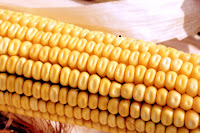How to select corn seed to save
 A few large agribusiness companies have great influence over the kinds of corn, soybeans, wheat, etc. that we grow in America. This wasn't always true. Farmers used to save a portion of each crop as seed for the next year.
A few large agribusiness companies have great influence over the kinds of corn, soybeans, wheat, etc. that we grow in America. This wasn't always true. Farmers used to save a portion of each crop as seed for the next year.My 1919 agriculture textbook describes how a farmer should select ears of corn from his field for the next year's seed.
Seed corn should be selected in the field directly from the growing stalk. This should be done before the general harvesting and before a frost.
When the husks and lower leaves have turned yellow and the kernels of corn are glazed, the corn is mature enough to be gathered. The ears should be typical of the variety in size, shape, color, and indentation.
The plant from which the ears are selected should be strong and leafy; it should have matured a little earlier than the main crop; and it should bear the ear at a height convenient for husking. that is, three or four feet from the ground... [I]t is essential that such ears be removed on the day it is gathered to a suitable place where it can quickly dry out or cure.
Source: An Introduction to Agriculture (pp. 84-85) by A. A. Upton and G. A. Schmidt, M.S. Copyright 1919 by D. Appleton and Company, New York.
The farmer was urged to do a germination test in February or March of the following spring, with a few kernels from each ear of corn he had saved If the sample seeds didn't sprout or if they produced weak seedlings, none of the seed from that ear should be planted.
In another chapter, the following characteristics of high quality seeds are listed:
1. Well matured and not more than two years old.
2. One hundred per cent pure.
3. Of a high weight per bushel.
4. Bright and have a live color and sweet odor.
5. Free from disease, injury, dirt and weed seeds.
6. Well graded [all imperfect seed removed].
7. A strong and high germination power.
Source: An Introduction to Agriculture (p. 130) by A. A. Upton and G. A. Schmidt, M.S. Copyright 1919 by D. Appleton and Company, New York.
Any gardener or farmer can become a seed saver. For best results, start by planting a non-hybrid seed. Then select the best seed from your crop, allow it to mature, dry it, and store it in a cool, dry place.
2 comments:
Heirloom corn! My old Aunties grew most everything in their gardens from saved seeds, and I do some of it myself.
I tried growing some acorn squash from seeds I saved but I'd forgotten that they were from a hybrid. The resulting squash were shaped like acorn squash, but had bright yellow skins and were almost tasteless.
I have a bunch of gourd seeds in the freezer that I've saved. I don't know if they are from hybrids or not, but I imagine that they will make gourds either way. Your tasteless acorn squash may have been a bit "gourdish."
My mother was quite a seed saver. She always had sacks of flower heads and aluminum pie pans of tomato and watermelon seeds stashed in the porch cabinets. (It was cold out there in the winter.)
Post a Comment